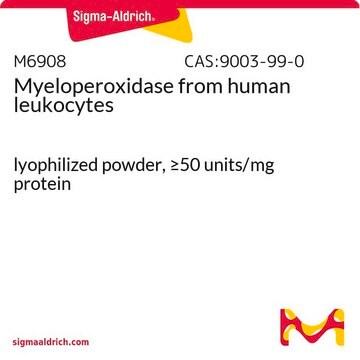390A
Leukocyte Peroxidase (Myeloperoxidase) Kit
Hanker-Yates substrate kit
About This Item
Polecane produkty
zastosowanie
sufficient for 10-120 manual assays
okres trwałości
Expiry date on the label.
IVD
for in vitro diagnostic use
Zastosowanie
hematology
histology
Warunki transportu
wet ice
temp. przechowywania
2-8°C
Szukasz podobnych produktów? Odwiedź Przewodnik dotyczący porównywania produktów
Zastosowanie
Tylko elementy zestawu
- Acid Hematoxylin Solution (2852) 100 mL
- Peroxidase Indicator Reagent (3901) 10 vial(s)
Elementy zestawu są też dostępne oddzielnie
- 903CTRIZMAL™ 6.3 Buffer Concentrate, pH 6.3(concentrate), 0.2 M 50 mLKarta charakterystyki
produkt powiązany
Hasło ostrzegawcze
Danger
Zwroty wskazujące rodzaj zagrożenia
Zwroty wskazujące środki ostrożności
Klasyfikacja zagrożeń
Acute Tox. 3 Dermal - Acute Tox. 3 Oral - Acute Tox. 4 Inhalation - Aquatic Acute 1 - Aquatic Chronic 1 - Carc. 1B - Eye Dam. 1 - Muta. 2 - Skin Irrit. 2 - Skin Sens. 1
Kod klasy składowania
6.1C - Combustible acute toxic Cat.3 / toxic compounds or compounds which causing chronic effects
Temperatura zapłonu (°F)
Not applicable
Temperatura zapłonu (°C)
Not applicable
Certyfikaty analizy (CoA)
Poszukaj Certyfikaty analizy (CoA), wpisując numer partii/serii produktów. Numery serii i partii można znaleźć na etykiecie produktu po słowach „seria” lub „partia”.
Masz już ten produkt?
Dokumenty związane z niedawno zakupionymi produktami zostały zamieszczone w Bibliotece dokumentów.
Klienci oglądali również te produkty
Nasz zespół naukowców ma doświadczenie we wszystkich obszarach badań, w tym w naukach przyrodniczych, materiałoznawstwie, syntezie chemicznej, chromatografii, analityce i wielu innych dziedzinach.
Skontaktuj się z zespołem ds. pomocy technicznej

















